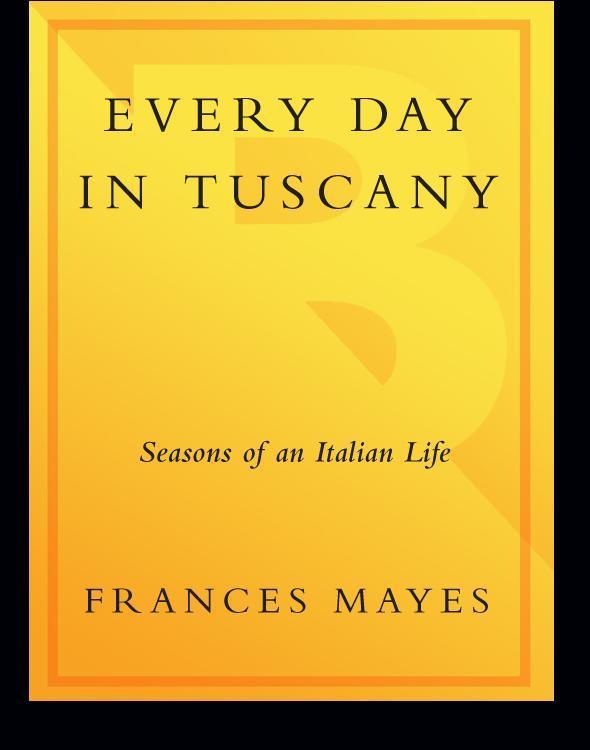
Every Day in Tuscany
Seasons of an Italian Life
کتاب های مرتبط
- اطلاعات
- نقد و بررسی
- دیدگاه کاربران
نقد و بررسی

January 11, 2010
In her most recent Tuscan tour, Mayes conducts readers through the gentle and sometimes violent and disruptive undulations of the seasons from winter to summer in her Tuscan home of Bramasole. In this new memoir, she reflects on the palpable scents emitted by the old-growth chestnut, apple, and olive trees, the jovial hospitality and strength of her friends and neighbors, and the familiar and sometimes disturbing sounds of herds of wild boars rushing through the orchards. Mayes and her husband, Ed, situated themselves even more firmly in Tuscany a few years ago when they discovered a falling-down stone cottage on a rugged slope and restored it as a second home. We follow Mayes as she forages for the prized amarini
, cherries the size of five-caret rubies, which are bottled with alcohol and brought out in winter to spoon over polenta cake, pears, blackberries, asparagus, fennel flowers, and figs. We continue on our journey with her as she leads us in search of the great Renaissance artist Luca Signorelli from Cortona, where her new house lies. Mayes’s affectionate and warm memoir vividly celebrates the lush abundance and charm of daily life in the Italian countryside.

January 1, 2010
Mayes (A Year in the World: Journeys of a Passionate Traveller, 2006, etc.) continues to gather voluptuous memories in Tuscany…and Umbria, Liguria, the Marche and beyond.
This collection of two-dozen set pieces finds the author true to her romantic form—hungry to live as close to the bone in her corner of Tuscany as possible, to drink in equal measure from the local wine, the paintings of Luca Signorelli, village folklore and the lilac morning sky. Occasionally she slips into deliquescence, but mostly she's stirring the reader's gastric juices with luscious tales from the table or tendering a descriptive nugget that holds fast in the mind's eye. This might be a day trip to nearby Loreto,"home of the house of the Virgin Mary, borne aloft by angels in 1294, and blown in a storm from Croatia, where it had paused en route from Nazareth"; a morning spent foraging asparagus, fennel flowers and figs; an owl that lifts the roof tiles and squeezes into the attic; or finding a grenade, with accompanying warning note, in her front yard. This last event was the result of a certain dissenting brashness she brought to a civic issue. Understandably distraught, Mayes never quite convinces the reader that the"bomba" will end her days in Cortona, but rather she will learn how to get her opinion heard without discovering explosives in the garden. Food is the pivot around which her days swing, and Mayes serves it forth with brio and dash—and recipes, including stuffed and fried olives, Parmesan flan and chicken under a brick. If the parade of art, food, elemental landscape and abiding camaraderie gives the reader a case of eye-ache and envy, the author can only be admired for having worked hard to earn the life and for celebrating it with such genuine relish.
Mayes the sensualist in full bloom.
(COPYRIGHT (2010) KIRKUS REVIEWS/NIELSEN BUSINESS MEDIA, INC. ALL RIGHTS RESERVED.)

January 15, 2010
Mayes adds yet another book to the growing body of expatriate travel memoir, a genre she helped launch with "Under the Tuscan Sun". This time her prose feels more like a pastiche of journal entries than a coherent narrative. Mayes has lived a life of privilege; few of us can afford a second home anywhere, let alone in Italy, and few of us enjoy frequent restaurant meals, abundant leisure time, and opportunity for lavish entertaining. That Mayes can, and does, doesn't diminish the quality of her writing. Her passion for the Renaissance painter Luca Signorelli results in a chapter devoted to seeking out his works, thus providing an excellent traveler's micro-guide. She frequently ends chapters with recipes, many of which are easily duplicated, and there's an abundance of introspection to balance accounts of feasts with friends. This book is most easily read in bits and pieces, and Tuscan life comes off well. So it may surprise some that the place Mayes considers home isn't Italy but North Carolina. VERDICT Many fans of Mayes will want to complete her trio of Tuscan musings, while others may prefer to save their book dollars for a less overdone destination. [See Prepub Alert, "LJ" 11/1/09.]Janet Ross, Sparks Branch Lib., Nevada
Copyright 2010 Library Journal, LLC Used with permission.

February 15, 2010
Almost 20 years have passed since Mayes planted roots in a dilapidated (read: insanely charming) old farmhouse outside the Tuscan hill town of Cortona. Now, in her third memoir, she takes us to her second Italian abode, a rundown (read: cozy and idyllic) cottage in the woods. We take an hour walk to gather the makings for tonights dinner, we smell the lemon trees growing in the next room over; were right there with Mayes, fighting every urge to jump straight into these sun-soaked and citrus-scented pages. Also on the menu: Mayes serves up a delightful smattering of the recipes that she has the undisputed privilege to enjoy during lengthy dinners with friends. Following in the tradition of her first two memoirs, Under the Tuscan Sun (1996) and Bella Tuscany (1999), Mayes is generous with her thoughts, and her evocative writing simply oozes charm and warmth. In these times, this quick read is a thoroughly enjoyable way to visit Italy without once considering the heartbreaking dollar-to-euro conversion rate.(Reprinted with permission of Booklist, copyright 2010, American Library Association.)

























دیدگاه کاربران